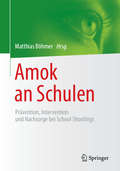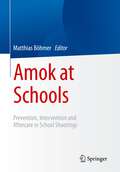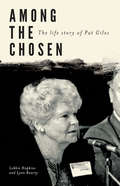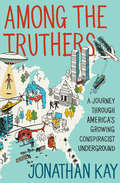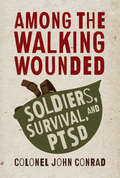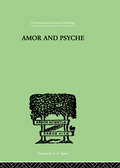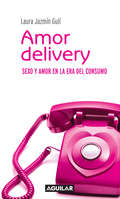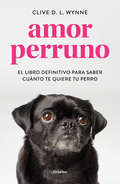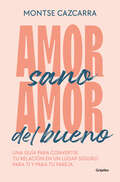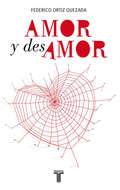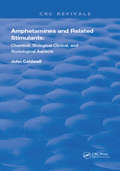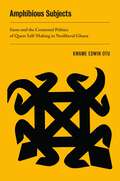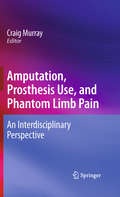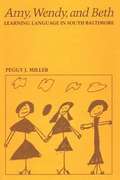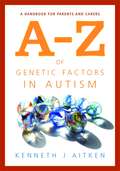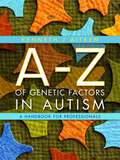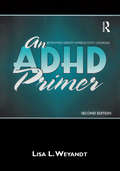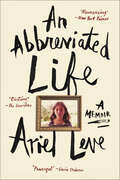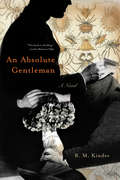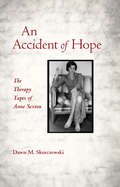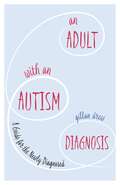- Table View
- List View
Amnesia and Redress in Contemporary American Fiction
by Marni GauthierThis book shows how a political and cultural dynamic of amnesia and truth telling shapes literary constructions of history. Gauthier focuses on the works ofDon DeLillo, Toni Morrison, Michelle Cliff, Bharati Mukherjee, and Julie Otsuka. "
Amok an Schulen: Prävention, Intervention und Nachsorge bei School Shootings
by Matthias BöhmerSchool Shootings - umgangssprachlich auch als Amokläufe an Schulen bezeichnet - stellen eine seltene, aber schwerwiegende Form von zielgerichteter Gewalt an Schulen dar. Dieses Buch stellt erstens die in der aktuellen wissenschaflichen Forschung diskutierten Ursachen dar. Neben Tätermerkmalen wird auf das private wie schulische Lebensumfeld , den Einfluss von Massenmedien, die Zugänglichkeit zu Waffen sowie auf den Konsum gewalthaltiger Medien abgehoben. Zweitens werden primär- und sekundärpräventive Maßnahmen dargestellt wie das Profiling, Threat Assessments sowie das Phänomen des Leakings. Und drittens liegt der Fokus auf der Nachsorge bei School Shootings, deren Ziel es ist, erlebte psychotraumatische Belastung zu bewältigen. Es werden notfallpsychologische Akuthilfen, kurzfristige bis mittelfristige, traumafokussierte, sowie längerfristige Interventionsmassnahmen für Kinder, Jugendliche und Erwachsene näher erläutert. Praxisexkurse zur Prävention als auch zur Nachsorge ergänzen die entsprechenden Kapitel.
Amok at Schools: Prevention, Intervention and Aftercare in School Shootings
by Matthias BöhmerSchool shootings - colloquially referred to as school rampages - represent a rare but serious form of targeted violence in schools. This book first presents the causes discussed in current scientific research. In addition to perpetrator characteristics, emphasis is placed on the private and school environment, the influence of mass media, accessibility to weapons, and the consumption of violent media. Secondly, primary and secondary preventive measures are presented, such as profiling, threat assessments and the phenomenon of leaking. And thirdly, the focus is on aftercare in school shootings, the aim of which is to cope with experienced psychotraumatic stress. Emergency psychological acute aids, short-term to medium-term, trauma-focused, as well as longer-term intervention measures for children, adolescents and adults are explained in more detail. Practical excursions on prevention as well as aftercare complement the corresponding chapters.
Among the Chosen: The Life Story of Pat Giles
by Lekkie Hopkins Lynn RoartySpotlighting a woman who was strongly dedicated to improving the lives of the disadvantaged, this biography celebrates the accomplishments of Pat Giles. Her entrance into Parliament as a Labor politician is reviewed, acknowledging that she came on board not as a raw recruit but as an experienced trade unionist, policymaker, feminist campaigner, and grassroots activist. This account reveals a woman whose determination never faltered and whose work ethic never flagged, telling the story of an activist working from within the established order to effect social change.
Among the Lesser Gods: A Novel
by Margo CattsFor fans of authors like Barbara Kingsolver and Leif Enger, a stunning new voice in contemporary literary fiction."Tragedy and blessing. Leave them alone long enough, and it gets real hard to tell them apart." Elena Alvarez is living a cursed life. From the deadly fire she accidentally set as a child, to her mother's abandonment, and now to an unwanted pregnancy, she knows better than most that small actions can have terrible consequences. Driven to the high mountains surrounding Leadville, Colorado by her latest bad decision, she's intent on putting off the future. Perhaps there she can just hide in her grandmother's isolated cabin and wait for something–anything–to make her next choice for her. But instead of escape, she finds reminders of her own troubles reflected from every side–the recent widower and his two children adrift in a changed world, Elena's own mysterious family history, and the interwoven lives within the town itself. Bit by bit, Elena begins to reconsider her role in the tragedies she's held on to and the wounds she's refused to let heal. But then, in a single afternoon, when threads of cause and effect tangle, Elena's fragile new peace is torn apart. It's only at the prospect of fresh loss and blame that she will discover the truth of the terrible burdens we take upon ourselves, the way tragedy and redemption are inevitably bound together–and how curses can sometimes lead to blessings, however disguised.
Among the Truthers: A Journey Through America's Growing Conspiracist Underground
by Jonathan KayFrom 9/11 conspiracy theorists and UFO obsessives tothe cult of Ayn Rand and Birthercrusaders, America is suffering from an explosion in post-rationalistideological movements. In Among the Truthers,journalist Jonathan Kay offers a thoughtful and sobering look at how socialnetworking and Web-based video sharing have engendered a flourishing of new conspiracism. Kay details the sociological profiles of tenbrands of modern conspiracists—the Failed Historian,the Mid-Life Crack-Up, the Damaged Survivor, the Campus Revolutionary, theStoner, the Clinical Case, the Puzzle Solver, the Christian Doomsayer, the CosmicVoyager, and the Egomaniac—in a compelling exploration of America’s departurefrom reason and what it means for the very future of rational discourse as thenation steps further into the 21st century.
Among the Walking Wounded: Soldiers, Survival, and PTSD
by Colonel John Conrad<p>A gripping account of PTSD, and a stark reminder that, for many, wars go on long after the last shot is fired. <p>In the shadows of army life is a world where friends become monsters, where kindness twists into assault, and where self-loathing and despair become constant companions. Whether you know it by old names like “soldier’s heart,” “shell shock,” or “combat fatigue,” post-traumatic stress disorder has left deep and silent wounds throughout history in the ranks of fighting forces. <p><i>Among the Walking Wounded</i> tells one veteran’s experience of PTSD through an intimate personal account, as visceral as it is blunt. In a courageous story of descent and triumph, it tackles the stigma of PTSD head-on and brings an enduring message of struggle and hope for wounded Canadian veterans. This book is a must-read for anyone who cares about Canadian veterans and the dark war they face long after their combat service is ended.</p>
Amongst Ourselves: A Self-Help Guide to Living With Dissociative Identity Disorder
by Tracy Alderman Karen MarshallWhat is DID? How can you cope with having it? How do you find a good therapist you can trust? What are good things about having DID? Tracy Alderman, Ph.D. and Karen Marshall, L.C.S.W. answer all of these questions and more. DID is not a life sentence, it can be fun! You are a survivor. Open up this book and find out why!
Amor And Psyche: THE PSYCHIC DEVELOPMENT OF THE FEMININE (Works By Erich Neumann Ser. #6)
by Neumann, ErichFirst Published in 1999. Routledge is an imprint of Taylor & Francis, an informa company.
Amor delivery
by Laura Jazmín GulíLaura Jazmín Gulí, licenciada en Psicología y especialista en terapias de pareja, analiza y explica de manera novedosa el tema de la sexualidad y el amor. ¿Es posible mantener la pasión después de veinte años de convivencia? ¿Se puede superar un engaño entre dos seres que dicen amarse? ¿El sexo ocasional es también una entrega de carácter sagrado? ¿Puede el amor durar para siempre? A partir de las experiencias recogidas a lo largo de veinte años de trabajo, la autora propone en este libro la posibilidad de rebelarse contra el Amor delivery, a favor del Amor y la Vida. La sexualidad ocupa gran parte del interés de la sociedad. Cada vez hay más libros de divulgación, más expertos, más seminarios y conferencias; cada vez son más las ofertas, las recetas para ?triunfar?, como si el sexo fuera una carrera hacia el éxito, una autopista que desemboca en la satisfacción inmediata y garantizada. En realidad, lo único que conseguimos con todo esto es banalizar el sexo y el amor, convertirlos en bienes de consumo y alejarnos de la plenitud del verdadero placer. Laura Jazmín Gulí, licenciada en Psicología y especialista en terapias de pareja, analiza y explica de manera novedosa el tema de la sexualidad y el amor, redescubriendo el verdadero significado de ambos conceptos y despejando los obstáculos que nos impiden valorar el carácter misterioso y sagrado de la verdadera unión entre dos personas.
Amor perruno: El libro definitivo para saber cuánto te quiere tu perro
by Clive D.L. WynneLa guía perfecta para entender el amor de tu perro y saber cómo corresponderlo. Este es un libro para todos. ¿Por qué? Porque si tienes un perro, descubrirás cuánto te quiere y cuánto te necesita, y ya no podrás mirarlo con los mismos ojos; si no lo tienes y no te gustan, espero que, después de leer estas páginas, no pienses lo mismo. Y es que de todas las especies que habitan el planeta ninguna nos entiende tanto como los perros. No solo son el mejor amigo del hombre, sino que saben interpretar nuestro lenguaje corporal, nos lo dan todo a cambio de una caricia, siempre están dispuestos a perdonar y nunca, nunca nos abandonan. La guía más completa para entender el comportamiento de estos animales tan maravillosos, para saber qué necesitan en cada momento, y para aprender a cuidarlos y a respetarlos como se merecen.
Amor sano, amor del bueno: Una guía para convertir tu relación en un lugar seguro para ti y para tu pareja
by Montse CazcarraTodo lo que necesitas saber para convertir tu relación de pareja en un lugar seguro y construir un vínculo sano, pleno y duradero. ¿Tienes la sensación de que tu pareja y tú no os entendéis? ¿Vuestras discusiones suben de tono fácilmente? ¿Los conflictos se acumulan y no se reparan? ¿Os sentís cada vez más alejados y emocionalmente desconectados?Las relaciones deberían ser un entorno seguro, un lugar en el que crecer juntos, que promueva el bienestar y no todo lo contrario. Para conseguirlo, la psicóloga Montse Cazcarra propone observar a nuestra pareja y lo que sucede dentro del vínculo para comprender, aprender y, así, sentirnos más cerca a pesar de las diferencias. Un ejercicio de introspección en el que * te sumergirás en la teoría del apego y comprenderás cómo los primeros vínculos pueden estar influyendo en tu relación de pareja; * aprenderás a comunicarte teniendo en cuenta tanto tu mundo emocional como el de tu pareja; * comprenderás que tu sistema nervioso tiene un impacto en tus respuestas y en tus interacciones; * identificarás tus necesidades emocionales y aprenderás a ver las de tu pareja. Con Amor sano, amor del bueno te volverás experto en ti, en tu pareja, en lo que cada uno de vosotros necesita, en lo que os molesta, en lo que os ayuda a sentiros vistos, escuchados, validados, seguros y queridos. «Montse es sabiduría y corazón a la vez. Siento que estas líneas aportan un rayo de luz en la oscuridad. Su manera de comunicar y darte respuestas te indica el camino a seguir. En este libro podrás encontrar una guía para conocer las relaciones de amor del bueno». MARTA SEGRELLES, psicóloga integradora y autora de Abraza a la niña que fuiste «Lo que hace tan especial a Montse es su forma de mezclar la rigurosidad y la sensibilidad a la hora de exponer su trabajo. Este libro es un paso a paso para construir una relación sana desde sus cimientos y toca todos los temas necesarios para que tu relación funcione». SILVIA LLOP, psicóloga y autora de Mándalo a la mierda, mereces algo mejor «Este libro es un manual maravilloso donde aprenderás a conocerte, cuidarte y quererte, y construir relaciones sanas y recíprocas, donde tú y tu pareja os podáis sentir vistos, queridos y seguros».NOEMÍ SEVA, trabajadora social y autora de Ámate y mucho «Este libro nos muestra cómo ser equipo y construir una base sólida y segura en nuestras relaciones. Montse nos invita a entender y cuidar de la pareja desde una mirada compasiva y respetuosa que nos acerque al amor del bueno, el amor sano». MARÍA ROS, psicóloga y autora de Abraza tus partes rotas
Amor y desamor
by Federico Ortiz QuezadaExplora el conocimiento que la humanidad ha atesorado sobre el amor romántico y erótico a partir de la mitología, la literatura, el arte, la biología, la antropología, la psicología, la filosofía, la ética y la medicina. Federico Ortiz Quezada vierte su experiencia vital, su conocimiento como médico y su riqueza cultural para brindarnos un libro de cabecera. Podemos consultarlo para conocer algún mito u obra literaria, para informarnos acerca de algunas disfunciones sexuales o para comprender las raíces de nuestras emociones. Su riqueza y universalidad nos llevarán a conocernos de una manera más completa, más profunda, más humana. La primera parte se ocupa del amor: los distintos tipos que hay; su origen; el lugar donde se asientan los mecanismos de la emoción amorosa; las sustancias químicas involucradas; lo que buscan hombres y mujeres en él; el sentido de las relaciones sexuales; las razones de los celos; el papel de la religión en las concepciones amorosas de Occidente; la representación del amor en la historia de la literatura; la censura a la homosexualidad; el futuro del amor y más. La segunda parte aborda el desamor: sus causas antropológicas, psicológicas y culturales; sus efectos sobre la salud; las razones por las cuales dejamos de amar; los aspectos éticos de la ruptura; la impotencia sexual y la amatoria; la misoginia y la androfobia.
Amor y desamor en el cerebro: Descubre la ciencia de la atracción, el sexo y el amor
by Eduardo CalixtoDescubre lo que realmente pasa en tu cerebro cuando te enamoras, cuando el deseo sexual explota en tus sentidos o cuando los celos te torturan. Cuando nos enamoramos el mundo es brillante y colorido, ella o él son lo máximo, poseen las más grandes virtudes, son hermosos, ¡perfectos! Pero qué pasa cuando ella o él deciden terminar la relación sin tomar en cuenta nuestros sentimientos: todo se vuelve dolor, tristeza, oscuridad# ¿Qué fue de tan inmenso amor? ¿A dónde volaron las mariposas que sentíamos en el estómago? ¿Por qué me han roto el corazón? Lo cierto es que ni tenías mariposas en el estómago -quizá algunos bichos sí-, ni te rompen nada: sólo ocurre que tu cerebro responde a las emociones y a los hechos de formas diversas, un mágico coctel de oxitocina, adrenalina, dopamina, endorfinas, y demás cosa fina, arman tremenda fiesta en tu cabeza. En este libro cautivante, el doctor Eduardo Calixto explica con gran claridad el papel del cerebro cuando nos enamoramos, sentimos un deseo sexual, experimentamos celos o la nostalgia se apodera de nosotros si terminamos una relación que nos hacía felices. A partir de numerosas historias de vida, testimonios divertidísimos, trágicos, conmovedores, incluso del más puro terror, el doctor Calixto revela diferentes tipos de personalidades en las relaciones: los manipuladores, los violentos pasivos, los mentirosos compulsivos, los codependientes, los infieles. En sus palabras, la compleja terminología de la neurociencia se vuelve accesible y fácil.
Amphetamines and Related Stimulants: Chemical, Biological, Clinical, and Sociological Aspects (Routledge Revivals)
by John CaldwellFirst published in 1980: The current texts represent the state-of-the-art on the use and abuse of amphetamines and related stimulants, from chemical, pharmacological, clinical, and social aspects.
Amphibious Subjects: Sasso and the Contested Politics of Queer Self-Making in Neoliberal Ghana (New Sexual Worlds #2)
by Kwame Edwin OtuA free open access ebook is available upon publication. Learn more at www.luminosoa.org.Amphibious Subjects is an ethnographic study of a community of self-identified effeminate men—known in local parlance as sasso—residing in coastal Jamestown, a suburb of Accra, Ghana's capital. Drawing on the Ghanaian philosopher Kwame Gyekye's notion of "amphibious personhood," Kwame Edwin Otu argues that sasso embody and articulate amphibious subjectivity in their self-making, creating an identity that moves beyond the homogenizing impulses of western categories of gender and sexuality. Such subjectivity simultaneously unsettles claims purported by the Christian heteronationalist state and LGBT+ human rights organizations that Ghana is predominantly heterosexual or homophobic. Weaving together personal interactions with sasso, participant observation, autoethnography, archival sources, essays from African and African-diasporic literature, and critical analyses of documentaries such as the BBC's The World’s Worst Place to Be Gay, Amphibious Subjects is an ethnographic meditation on how Africa is configured as the "heart of homophobic darkness" in transnational LGBT+ human rights imaginaries.
Amputation, Prosthesis Use, and Phantom Limb Pain: An Interdisciplinary Perspective
by Craig MurrayThe book will contain contributions from the fields of anthropology, biomedical engineering, computer science, neuroscience, nursing, prosthetics and orthotics, psychology, and rehabilitative medicine. It will be comprised of three broad interrelated sections. Following an introductory chapter in which the topics and chapters of the book are overviewed, the first section ("Providing and Monitoring the Use of Prostheses") will concentrate on the work of prostheticians and will consist of three chapters. The first of these, written by a clinician responsible for the provision of prosthetics in a large regional area of the UK, will present a range of ethical and medico-legal issues for rehabilitation professionals in the supply and withdrawal of prostheses and assistive technology for people with limb loss or deformity. The second chapter, provided by a prosthetician and prosthetic engineers, will present the development of an innovative computerized technique for monitoring upper limb prosthesis activity. The final chapter in this section is written by an anthropologist, himself an amputee, presenting ethnographic work on how prostheticians and their clients actually "go about" providing artificial limbs. Together these chapters explicate the processes involved in prostheticians' work with clients in a manner which will be of interest to students and professionals from a range of disciplines. Section 2 ("The Experience and Meaning of Prosthesis Use") focuses on the experiences and meanings of prosthesis users themselves. The first of three chapters, written by members of the Dublin Psychoprothetics Group, explores the ways in which people adapt and cope with limb loss and using a prosthesis, the potential for positive adjustment and strengths emerging from the experience, pain, affective distress, issues around identity, body image, and the construction of self and quality of life. It also considers the importance of these issues for health service providers across the multidisciplinary team who work with people with limb loss. The second chapter provides a reflective critique of the themes in the book, namely, the process of prosthetic rehabilitation, by way of a reprint of Gelya Frank's classic paper "Beyond Stigma: Visibility and Self-Empowerment of Persons with Congenital Limb Deficiencies," along with a new commentary from the author herself. This chapter focuses on the experiences of people born with congenital limb deficiencies who have chosen not to use prosthetics as part of a strategy to counteract the stigmatization of disability and bodily difference. The views of these participants provide challenges to a range of professionals involved in the rehabilitation of people with amputations and limb deficiencies. The final chapter of this section presents a range of themes in the experiences of people who choose to use prosthetics following amputation or limb absence, including the embodied used of prosthesis and the integration of these into the identity of the persons concerned. The final section (postoperative pain and new treatments of phantom limb pain) focuses on phantom limb pain and emerging therapies for this phenomenon. The first of four chapters presents a clinician's account of post amputation pain, stressing how this is temporally dependent, varying at different stages of the perioperative/postoperative period, with possibly more than one pain being present at any time. In considering the complex amalgam of pain contributors the author argues for a full biopsychosocial assessment to be made with attention and treatment given to any associated mood disorder, disorder of cognition or behavioral maladaptations. These considerations are developed further in the following chapter where, written from a nursing perspective, the coping style of patients in relation to phantom limb pain are discussed and compared with other pain conditions. The final two chapters in this section present two emerging therapies for phantom limb pain which have received particular academic and media attention. This condition ...
Amy, Wendy, and Beth: Learning Language in South Baltimore
by Peggy J. MillerAmy, Wendy, and Beth, the 1980 recipient of the New York Academy of Sciences Edward Sapir Award, is a lively in-depth study of how three young children from an urban working-class community learned language under everyday conditions. It is a sensitive portrayal of the children and their families and offers an innovative approach to the study of language development and social class. A major conclusion of the study is that the linguistic abilities of working-class children are consistent with previous cross-cultural accounts of the development of communicational skills and, as such, lend no support to past claims that children from the lower classes are linguistically deprived. Instead, Amy, Wendy, and Beth emerge as able and enthusiastic language learners; their families, as caring and competent partners in the language socialization process. Sound scholarship and original findings about a hitherto neglected population of children lend special value to this work not only for scholars in psychology, linguistics, and anthropology, but for educators and policymakers as well.
An A-Z of Genetic Factors in Autism
by Kenneth J. AitkenThe concept of a single condition known as 'autism' is quickly becoming outdated, and is now understood to be an umbrella term for a variety of predominantly genetic conditions. This can be confusing for parents of children who have been diagnosed as having an 'autism spectrum disorder'. An A-Z of Genetic Factors in Autism provides parents with a complete overview of the main genetic disorders associated with autism, including those linked to growth differences, cardiovascular issues, neurodevelopmental problems, immune dysfunction, gastrointestinal disturbances and epilepsy. Kenneth Aitken demystifies the umbrella term 'autism' by alphabetically listing these conditions along with information about how common they are, their causes, signs, and symptoms, and for many, appropriate methods of treatment and management. Information on support groups and sources of further information are also included to help parents obtain any additional support they need, and keep up to date with new developments in research and practice. This is a must-have book for any parent or carer who feels confused by their child's diagnosis, or who seeks a better understanding of the many genetic conditions linked to autism.
An A-Z of Genetic Factors in Autism: A Handbook for Professionals
by Kenneth AitkenOur understanding of the biological bases to the autistic spectrum disorders (ASDs) is advancing rapidly. Over 80 genetic conditions have now been reported in people who have also been diagnosed with ASDs. Many of these conditions have specific implications for the presenting phenotype and for treatment, management, and intervention. If the basis to the presenting behavioural phenotype is not identified, this can result in a sub-optimal level of care, complications, or even permanent damage. Kenneth J. Aitken shows that the notion of a single condition known as 'autism' is no longer tenable, and challenges current trends in the diagnosis and management of these behaviours as a homogenous group by drawing on recent research into brain function, genetics, epidemiology and neurology. This volume explains the biology and genetics of ASD, and provides clinicians and researchers with a comprehensive summary of each genetic factor including the research that links it to ASD, diagnosis and treatment issues, and related animal models, as well as detailing relevant professional organisations and avenues for further research. An A-Z of Genetic Factors in Autism is an essential resource for a wide range of researchers, clinical professionals and students interested in autism spectrum disorders, including clinical and educational psychologists, dieticians, psychiatrists, and neurologists.
An ADHD Primer
by Lisa L. WeyandtFilled with current, practical, and useful information for professionals and individuals, this second edition of An ADHD Primer summarizes the literature concerning ADHD across the lifespan. It offers a better understanding of the disorder by addressing the potential causes of ADHD, the developmental course, and numerous treatment approaches. Author Lisa L. Weyandt delivers research-based, cutting-edge knowledge in a concise and user-friendly fashion. The book skillfully explains the scientific literature, often complex, concerning this disorder. Commonly asked questions are addressed, including: What causes ADHD? What does ADHD look like, and how can it be accurately assessed? How can ADHD be treated with and without medication? Weyandt thoroughly tackles these question and more. The text contains helpful tables and appendices, as well as numerous up-to-date resources for readers who desire additional information about the disorder. An ADHD Primer is intended for students enrolled in teacher-certification programs, graduate students enrolled in research and applied training programs, educators, counselors, nurses, psychologists, parents, and individuals with ADHD.
An Abbreviated Life: A Memoir
by Ariel Leve“Sometimes, a child is born to a parent who can’t be a parent, and, like a seedling in the shade, has to grow toward a distant sun. Ariel Leve’s spare and powerful memoir will remind us that family isn’t everything—kindness and nurturing are.” —Gloria SteinemAriel Leve grew up in Manhattan with an eccentric mother she describes as “a poet, an artist, a selfappointed troublemaker and attention seeker.” Leve learned to become her own parent, taking care of herself and her mother’s needs. There would be uncontrolled, impulsive rages followed with denial, disavowed responsibility, and then extreme outpourings of affection. How does a child learn to feel safe in this topsyturvy world of conditional love?Leve captures the chaos and lasting impact of a child’s life under siege and explores how the coping mechanisms she developed to survive later incapacitated her as an adult. There were material comforts, but no emotional safety, except for summer visits to her father’s home in South East Asia-an escape that was terminated after he attempted to gain custody. Following the death of a loving caretaker, a succession of replacements raised Leve-relationships which resulted in intense attachment and loss. It was not until decades later, when Leve moved to other side of the world, that she could begin to emancipate herself from the past. In a relationship with a man who has children, caring for them yields a clarity of what was missing.In telling her haunting story, Leve seeks to understand the effects of chronic psychological maltreatment on a child’s developing brain, and to discover how to build a life for herself that she never dreamed possible: An unabbreviated life.
An Absolute Gentleman: A Novel
by Kinder KinderA spine–chilling first novel loosely based on the author's real–life relationship with a convicted murderer, An Absolute Gentleman delves, with subtlety and tremendous psychological insight, into a serial killer's mind.Meet Arthur Bloom: charming guy, small–town English professor, struggling writer, and occasional murderer. In this beautifully articulated debut novel, R. M. Kinder brilliantly channels Arthur's voice to reveal the aberrant thought processes of a surprisingly sympathetic serial killer. Horror arises as it does in real life, in brief hints and disclosures that gradually reveal the complex nature of an all–too–human narrator.
An Accident of Hope: The Therapy Tapes of Anne Sexton
by Dawn M. SkorczewskiIn 1956, Anne Sexton was admitted into a mental hospital for post-partum depression, where she met Dr. Martin Orne, a young psychiatrist who treated her for the next eight years. In that time Sexton would blossom into a world-famous poet, best known for her "confessional" poems dealing with personal subjects not often represented in poetry at that time: mental illness, depression, suicide, sex, abortion, women's bodies, and the ordinary lives of mothers and housewives. Orne audiotaped the last three years of her therapy to facilitate her ability to remember their sessions. The final six months of these tapes are the focus of this book. In An Accident of Hope, Dawn Skorczewski links the content of the therapy with poetry excerpts, offering a rare perspective on the artist's experience and creative process. We can see Sexton attempting to make sense of her life and therapy and to sustain her confidence as a major poet, while struggling with the impending loss of Orne, who was moving elsewhere. Skorczewski's study provides an intimate, in-depth view of the therapy of a psychologically tortured yet immensely creative woman, during a period of emerging feminism and cultural change. Tracing the mutual development of the poet and the therapist during their years together, the author explores the tension between the classical therapeutic setting as practiced in the early 1960s and contemporary relational and developmental concepts in psychoanalysis, just then beginning to emerge. An Accident of Hope also raises broader questions about the nature of healing in psychotherapy. The poet and therapist we encounter in these sessions present complex and conflicted images of the therapeutic and creative process. Orne, equal parts honesty and hesitancy, works to bolster Sexton's self-image and maintain that she is more than the sum of her poetry. Sexton, working against a tendency to hide from her most painful feelings, valiantly pushes to tell the truth in therapy, while her poems invite the readers to see another side of the story. Just as Orne kept the audiotapes so that one day they might help others who suffer, An Accident of Hope tells the story of a therapy but moves beyond it. By offering a glimpse into the past, the present is open for reappraisal, both of Sexton herself and the legacy of psychoanalytic treatment.
An Adult with an Autism Diagnosis: A Guide for the Newly Diagnosed
by Gillan DrewBeing diagnosed with autism as an adult can be disorienting and isolating; however, if you can understand the condition and how it affects perceptions, relationships, and your relationship with the world in general, a happy and successful life is attainable. Through an introduction to the autism spectrum, and how the Level 1 diagnosis is characterised, the author draws on personal experiences to provide positive advice on dealing with life, health, and relationships following an adult diagnosis. The effect of autism on social skills is described with tips for dealing with family and personal relationships, parenting, living arrangements, and employment. Important topics include disclosure, available resources, and options for different therapeutic routes. On reading this book, you will learn a lot more about the autism spectrum at Level 1, be able to separate the facts from the myths, and gain an appreciation of the strengths of autism, and how autism can affect many aspects of everyday life. Drawing from the author's lived experience, this book is an essential guide for all newly diagnosed adults on the autism spectrum, their families and friends, and all professionals new to working with adults with ASDs.

